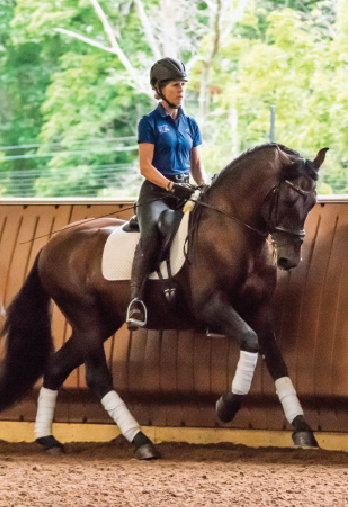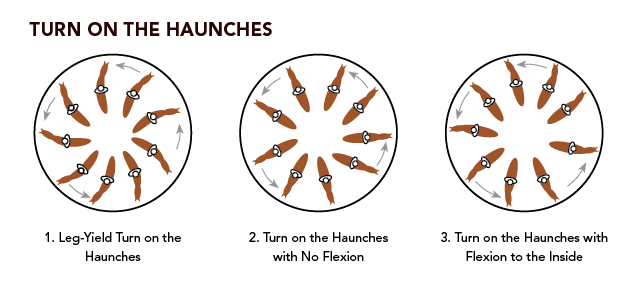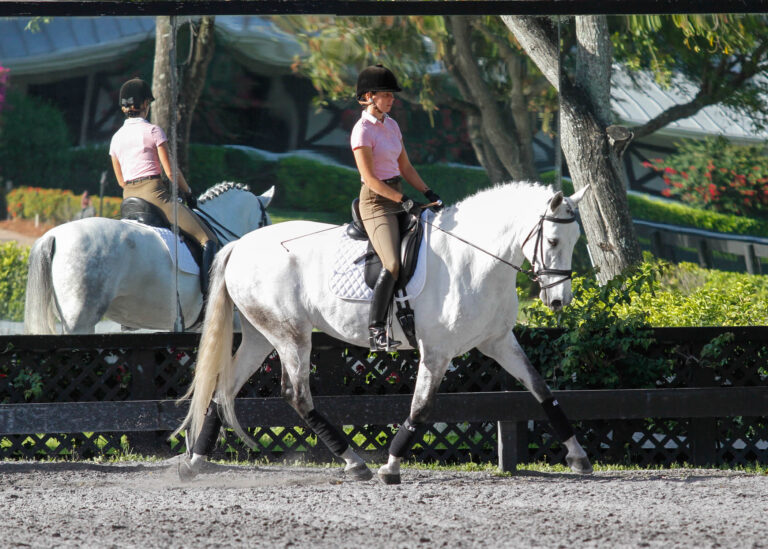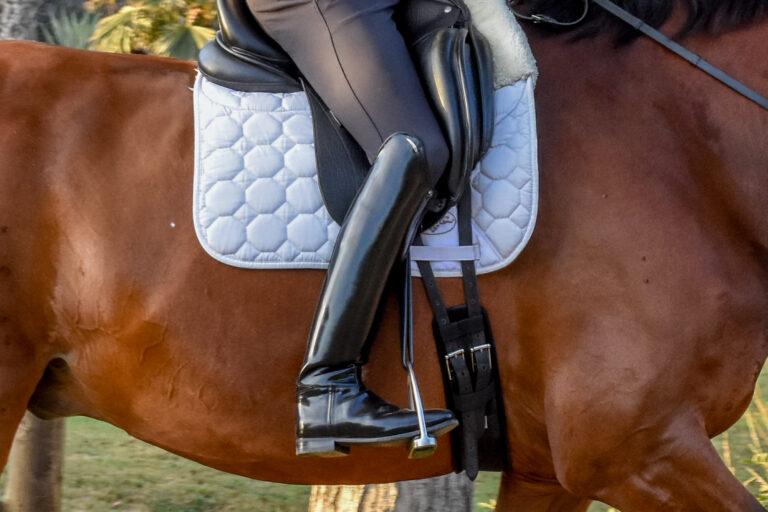It was September—time for the Old Master Series that is a regular occasion at Anke Ott Young’s Avalon Farm in North Salem, New York—and the great German educator Hubertus Schmidt was featured. The mission of the Old Master Series is for masters to share their wealth of knowledge gained through their lengthy riding and training careers. Schmidt has ridden 77 horses who have placed in the Grand Prix and 50 of those he started himself. That’s a lot of experience! Young makes these events free to auditors, and proceeds gathered from a silent auction, a raffle and donations go to the Norma Pfriem Breast Care Center.

Here are 14 tips worth sharing from Schmidt’s training sessions:
1. The Not-So-Boring Warm-Up
Some people think the warm-up is boring, but for Schmidt, it’s the most important part of the ride—the time when his horse develops the relaxation and suppleness that he will try to retain throughout the more difficult work. His warm-up is the same with every horse, whether it’s a 4-year-old or a Grand Prix horse, and he takes as much time as is needed.
2. How to Begin Your Warm-Up
Correct flexion and bend are the red line that follows through from the warm-up into all the rest of your ride. They are the preparation for every figure and movement, and they make the horse supple. Once correct flexion and bending are confirmed, it is easy to work the horse’s whole body in warm-up exercises that increase suppleness.
3. Suppleness Tests
Schmidt recommends transitions between working trot and working canter on a 20-meter circle to develop suppleness, throughness and straightness. Many riders have a problem with the accuracy of the 20-meter circle. But when you can get that and do the transitions with a consistent frame and contact, 100 percent correct bending, connection on the outside rein and lightness on the inside—and you can do that in both directions, it’s a clear sign that your horse is supple enough to begin collected work.
You can’t move on to the work session and collect if your horse runs when you use your seat and legs. You also need to be able to give the rein without the horse running away. With a hot horse, it can take a long time before you are able to push. (Schmidt means with the calf, not the whip and spur). You need to be able to close your calf and push to get collection. Figure eights can be effective to get a tense horse relaxed and swinging. The difficulty comes when a long warm-up makes a horse tired. A tired hot horse is even worse than a fresh hot horse because the tired horse runs as a result of his inability to carry the weight behind. Take breaks.
When a horse is using his back, he can stretch in trot and canter. If his neck is too high, he’s light in the hand and he can’t stretch; he’s absolutely not using his back. You must be able to make your horse longer and lower. When you ask your horse to stretch, do it with consistent contact—not with loose reins. If you need to take more time for your warm-up, do it.
4. Half-Halt for Collection
Schmidt’s philosophy throughout the training is to start with what is easy and then go on to the more difficult work. As a result, he always starts with whichever gait is the horse’s easiest. To develop collection in either trot or canter, he teaches riders to half-halt like this:
• Keep your hands steady.
• Push against those steady hands by making more pressure with your seat and legs.
As a result, the horse should develop collection with more swing and cadence and become light in the hand. (If you were to push and open your fingers, you would make your horse’s strides longer.)
The goal in collection is to develop gaits that cover a lot of ground with self-carriage and swing. You also want the horse to be connected on the outside rein and light on the inside rein. Then the inside hind is free to step through and engage. Remember that the point of dressage is to bring the weight from the front to the back.
A problem arises sometimes when, in collection, horses become tense. The neck gets too high, the horse loses his throughness and then the half-halt doesn’t work. When the neck isn’t perfect, the horse gets shorter in front instead of closing the frame from behind and lowering the hindquarters. You must correct this immediately by lowering the neck and riding the horse more through again. When the neck is in the right position again, half-halts work to develop correct collection.
5. Young Horses
Schmidt warned of the danger of succumbing to the temptation of riding for spectacular gaits with young horses. “Less is more,” he said often. When the basic gaits are ridden too actively, they lose their regularity.
6. Prepare for Every Figure and Movement
Prepare with flexion and bend. Flexion is in the poll and bending is throughout the whole body. You can have flexion with no bend, such as on the straight line, but you can’t have bend without flexion.

7. Take Breaks
Take many breaks during your work. Sometimes Schmidt gives a totally long rein and lets the horse relax completely. Sometimes he recommends a short break, keeping the consistent contact and doing a medium or extended walk. It’s important to train in the walk as well as in the trot and canter. In medium walk you can do figures and movements that improve the connection.
8. Make and Keep the Horse Sensitive
Every time you use your leg you must get a reaction from your horse. It can’t be that you need a spur to ask for trot or canter. Your hands are the same. If you give a rein aid to ask for flexion, for example, there must be a reaction.
Be sure to use the correct aids. If you push against the rein in a half-halt and your horse gets softer, you must immediately be softer, too. Overuse of the whip make horses insensitive. Use of the double bridle should not make the horse insensitive. When you first return to the snaffle, if the horse is more sensitive, it is proof that you used the double correctly.

9. Ride Corners
Prepare for corners with flexion and bend. A corner can be a quarter of a 10-meter, 8-meter or 6-meter circle. If you lose the rhythm in the corner, don’t go so deep into it. Make a shallower quarter circle or perhaps a 10-meter circle. Schmidt says that when he’s riding a test, he’s happy about every corner because the corners give him the opportunity to get his horse to sit more.
10. Shoulder-in and Half-Pass
For shoulder-in, prepare, as always, with flexion and bend in the corner. If that is correct, then you have everything you need for the shoulder-in. Likewise, when you turn onto the centerline with correct flexion and bend, you have everything you need to make a good half-pass to the long side.
Keep the exact rhythm in the shoulder-in and half-pass. Many horses start with a nice big trot, but when they go into their lateral work, the rhythm changes. Keep the big, swinging, forward, uphill attitude in all lateral work. Remember that the outside rein collects. You are not able to give your horse the proper advice if he’s not in the outside hand.
The trot will improve as the shoulder becomes freer, and the canter half-pass helps the horse sit and develop a more uphill posture. Your goal in half-pass is to get more cadence and swing, not more sideways. Half-pass is the best preparation for pirouette because the horse’s inside hind leg steps under the heavy point and carries more weight as it does in the pirouette.
11. Turn on the Haunches
Schmidt explains that the turn on the haunches is exactly the same as the walk pirouette, but larger. You do turn on the haunches from medium walk and pirouette from collected walk (or collected canter). Consider the difference between leg-yield and half-pass. In the leg-yield the horse steps away from the heavy point, but in half-pass he steps under the heavy point. Leg-yield is for warm-up and half-pass gets to the point by asking the horse to carry more weight behind.
Try this: Start on a small circle in whichever direction is easier. For example, start tracking left with the haunches slightly to the inside and leg-yield around the circle. Your horse is flexed slightly to the right and the shoulders turn to the left around the quarters (see Diagram 1).
Next, try the same exercise with a straight neck (see Diagram 2) and finally with a little flexion to the inside left (see Diagram 3). Be sure you are sitting to the inside as in half-pass. Your inside leg is in the normal position with the outside leg a hand back. Alternate between pushing with the inside leg and then outside, and your horse turns his shoulders around his hindquarters. Pirouette is the same in principle, but it is done on a smaller radius.

12. Canter Pirouette
Always practice the larger working pirouette because that gives you the chance to make corrections. If the neck is too high, you can make it low. If the horse starts to fall left or right, you can correct it. With small pirouettes, everything has to be 100 percent under control because there’s no chance to make any corrections.
Follow this step-by-step canter pirouette exercise:
1. Start with correct flexion and bending and an uphill canter.
2. Prepare with shoulder-fore because 100 percent of horses try to start canter pirouettes in haunches-in.
3. Prepare by lowering the horse’s neck so he can work through his whole back.
4. Be sure there’s not too much bend in the neck because when that’s the case the shoulder goes to the outside and you can’t turn.
5. Shorten the stride and collect the canter in preparation for a pirouette. The horse is allowed to slow the rhythm but he must stay active.
6. Turn the shoulders with the outside aids and keep every stride the same. Pirouette work is the hardest on the horse because the entire weight of the horse and rider is briefly on one leg. Be aware of that and don’t ask too much.

13. Flying Changes
Schmidt starts teaching flying changes when the horse can do very correct, through and straight transitions from walk to canter and canter to walk. The ability to change the flexion properly is also a prerequisite.
Teach the changes on a straight line, always to the horse’s easier direction first. If you teach flying changes in the corner, the horse gets used to falling to the new inside. In the preparation for the flying change, you must:
• Make your horse straight.
• Change the flexion.
• Put your horse into the new outside rein so he is light on the new inside, which allows the inside hind leg to step through.
• Ask for the change with the new outside leg and make the new inside rein loose.
• You want the aids to be easy, but sometimes a tap from the whip on the new outside can help.
It usually takes a good year before the horse can do a clear change to the left and to the right at any location. From there, two-tempi changes are only a few weeks away.
When starting series changes, don’t try to count because if the horse becomes crooked, tense or makes a mistake, you don’t want to do the next change. You want to wait until you regain the balance and then ask again. It’s only important to keep the quality and be sure you can give with the new inside rein in every change. When the changes are reliable, relaxed and the same left and right, start with four-tempis, then threes and twos. The preparation is always the same: make the horse straight, change the flexion and put him in the new outside rein. When you get to the one-tempis, however, there is not time to prepare and the horse stays straight on the line with the same contact left and right. In time the changes will gain height and ground coverage.
14. Piaffe
The horse must have a strong willingness to go forward with positive tension for good piaffe and passage. Schmidt always teaches piaffe before passage because piaffe makes the horse sit more so the hindquarters won’t be inclined to go out behind him. Early in his career, Schmidt used in-hand work to start piaffe with his horses. Then as he became a better rider, he started some horses under saddle. However, when a horse has difficulties, he often goes back to helping the horse in-hand. It takes at least one to two years for the piaffe to be good enough to ride in a test. He figures that if he starts when the horse is 6, the horse should be able to do the Young Horse Grand Prix as an 8-year-old.

Every demonstration horse-and-rider pair improved thanks to Schmidt’s endless generosity and to Young and her Avalon Farm’s commitment to furthering dressage education for all.
Hubertus Schmidt is one of the most successful dressage riders in the world. Throughout his career, Schmidt has brought more than 70 horses to the international Grand Prix level and coached several elite riders. Riding Wansuela Suerte, he was a member of the German team that won a gold medal at the 2004 Athens Olympic Games. The pair also won an individual silver medal at the European Championships the following year. In 2016, Schmidt and the Trakehner stallion Imperio were selected as the traveling reserve pair for the Rio de Janeiro Olympics. He and his wife, Doris, live at Fleyenhof in Paderborn, Germany.











